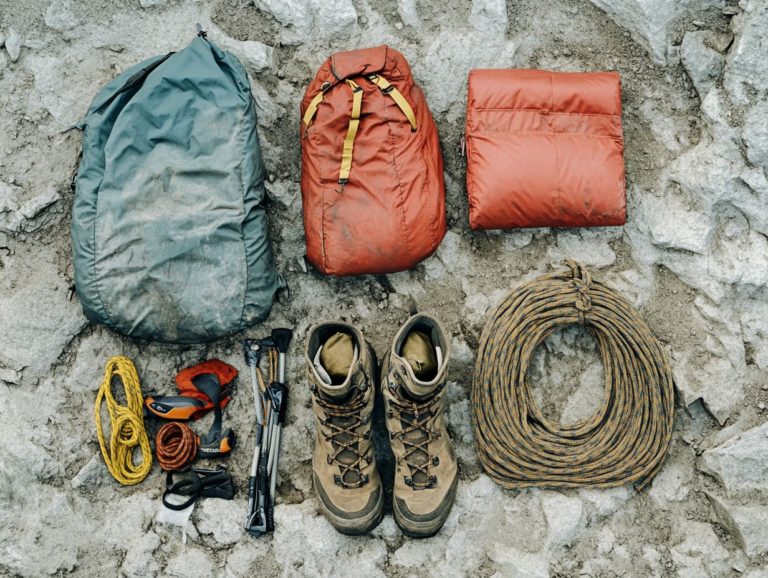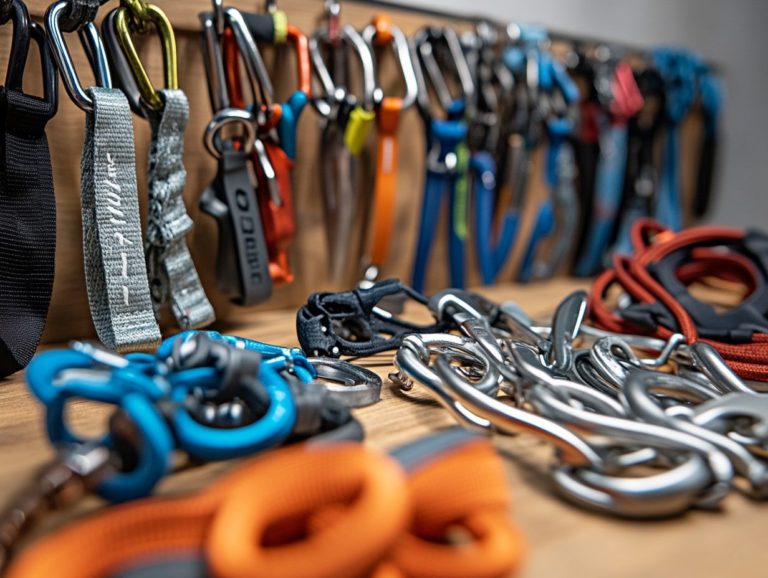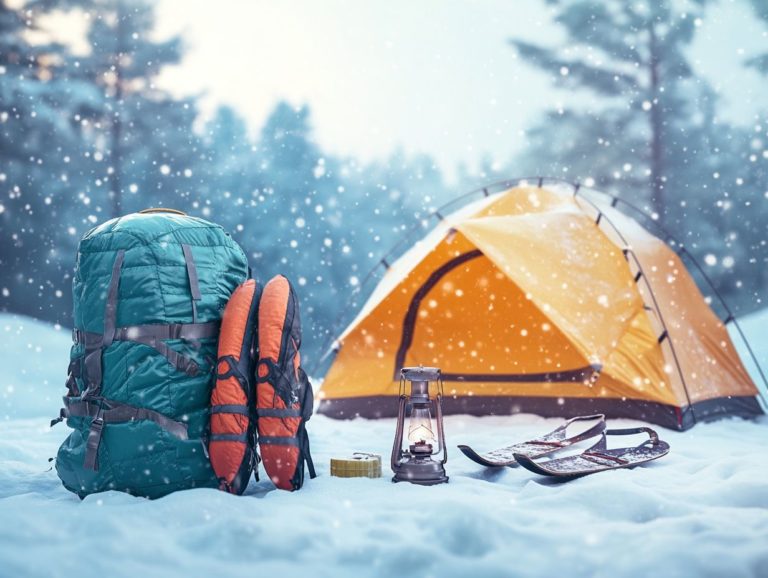How to Select the Right Sleeping Pad for Camping?
When you venture into the great outdoors, a good night’s sleep can truly transform your camping experience. The right sleeping pad not only offers comfort but also provides essential insulation and support. This ensures you wake up refreshed and ready for your next adventure.
This guide delves into the various types of sleeping pads air, foam, and self-inflating. It highlights key factors to consider when selecting one. You’ll also find tips on maintenance and recommendations for sleeping pads suited to different camping styles.
Prepare to discover your ideal companion for a cozy night beneath the stars with the right outdoor gear and camping mats!
Contents
- Key Takeaways:
- Types of Sleeping Pads
- Factors to Consider When Choosing a Sleeping Pad
- Features to Look for in a Sleeping Pad
- Tips for Maintaining and Using a Sleeping Pad
- Recommended Sleeping Pads for Different Camping Styles
- Frequently Asked Questions
- What factors should I consider when selecting a sleeping pad for camping?
- What type of sleeping pad should I choose for different weather conditions?
- Are inflatable or foam sleeping pads better for camping?
- How thick should a camping sleeping pad be?
- What size sleeping pad should I choose for camping?
- Can I use a regular air mattress as a sleeping pad for camping?
Key Takeaways:
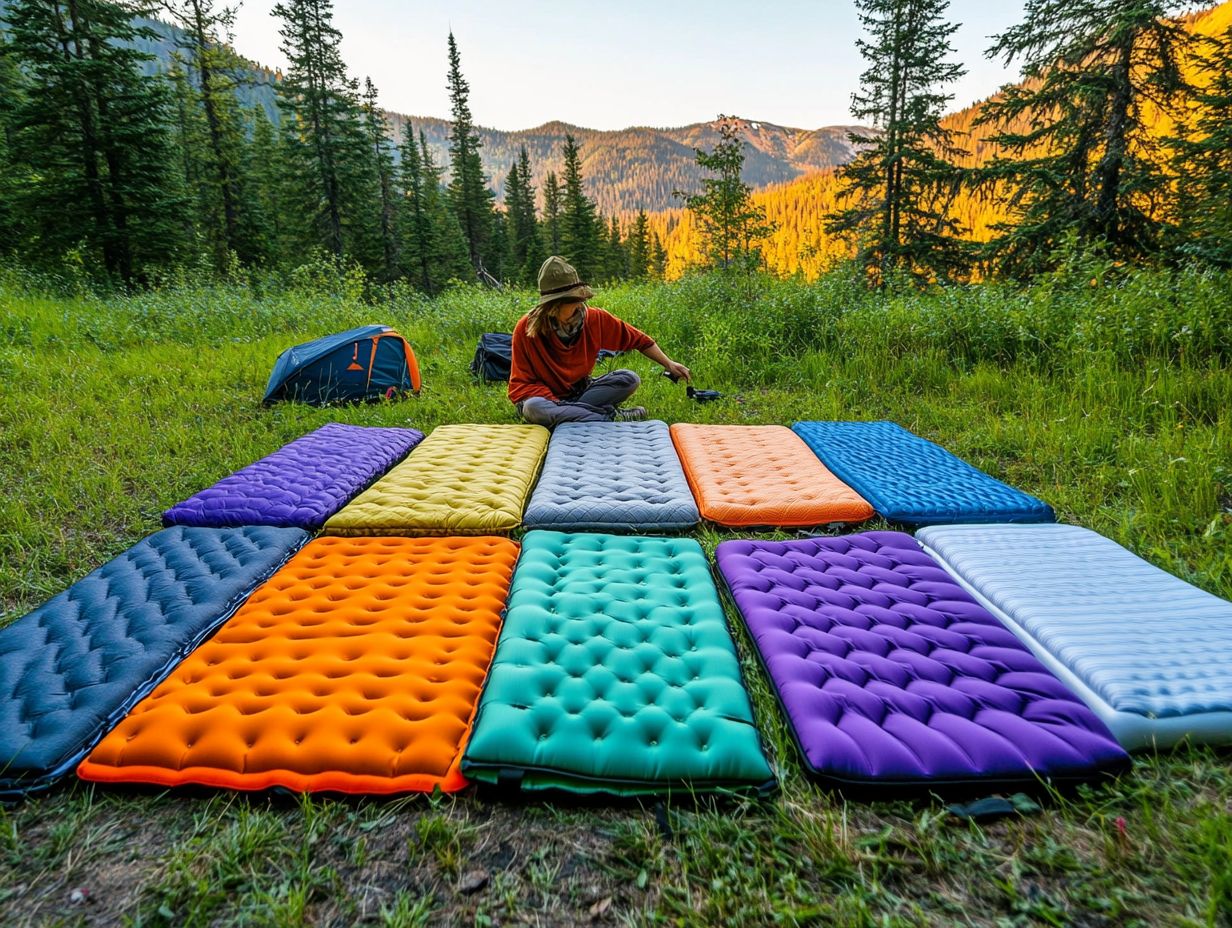
- Choose a sleeping pad based on your camping style backpacking, car camping, or family camping.
- Consider factors such as comfort level, insulation levels, and weight when selecting a sleeping pad.
- Look for features like size, thickness, and durability to ensure a comfortable and long-lasting sleeping pad, perfect for your camping trips.
Why a Sleeping Pad is Essential for Camping?
A sleeping pad is a crucial piece of your camping gear that elevates your outdoor experience. It provides the comfort and warmth you need during those nights spent beneath the stars. It also ensures effective insulation against the cold ground.
The sleeping pad acts as a cushion against the unforgiving ground and as a barrier that significantly reduces heat transfer. This helps you stay cozy in various climates, thanks to its ability to keep warmth in.
With the right sleeping pad, you can transform what might be an uncomfortable camping experience into a restful night. This is something every outdoor enthusiast values when seeking adventure without sacrificing comfort. Choosing the best pad can dramatically enhance your overall camping adventure, making it an essential addition to your backpacking gear for every trip.
When you compare it to other essentials like sleeping bags or tents, the sleeping pad plays a unique role that often goes underestimated. It provides a plush surface that alleviates pressure points and offers crucial insulation that a sleeping bag alone may not provide on chillier nights.
Working in harmony with your sleeping bag, these pads contribute to efficient heat retention, leading to a more restorative rest. For those who truly appreciate a good night s sleep, investing in a high-quality sleeping pad is a must for incredible comfort!
Types of Sleeping Pads
You ll find a variety of sleeping pads tailored for outdoor enthusiasts, including packable pads. Each is crafted with distinct features to suit different camping styles and preferences. Options range from air pads to closed-cell foam and self-inflating designs.
Choosing the right type can greatly influence your comfort, warmth, and overall camping experience. This is especially true for those who prefer lightweight gear. By understanding the nuances in design and materials, you can confidently select the perfect sleeping pad for your outdoor adventures.
Don’t wait any longer! Choose your sleeping pad now for an unforgettable camping experience!
Comparing Air, Foam, and Self-Inflating Pads
Compare air, foam, and self-inflating pads. Assess their construction, comfort, and insulation properties, especially the R-value.
The R-value measures how well the pad keeps you warm and resists heat loss. Air pads are often a top choice for their lightweight design and compact size when packed. They are ideal for backpacking and outdoor adventures.
If you prioritize durability and insulation, closed-cell foam pads shine, especially in colder climates. They provide effective insulation and thermal resistance. Meanwhile, self-inflating pads offer a versatile balance, merging the advantages of both air and foam.
Each pad type has its strengths, perfect for your unique camping adventure. Air-filled pads suit backpackers focused on minimizing weight, though they might sacrifice durability on rugged terrains.
On the other hand, closed-cell foam pads are nearly indestructible, making them an excellent option for those tackling harsher environments.
For car campers seeking extra comfort without the hassle of heavy gear, self-inflating pads are appealing. They offer both portability and a great sleeping system.
By exploring these distinctions, you can select the pad that best fits your adventurous spirit.
Factors to Consider When Choosing a Sleeping Pad
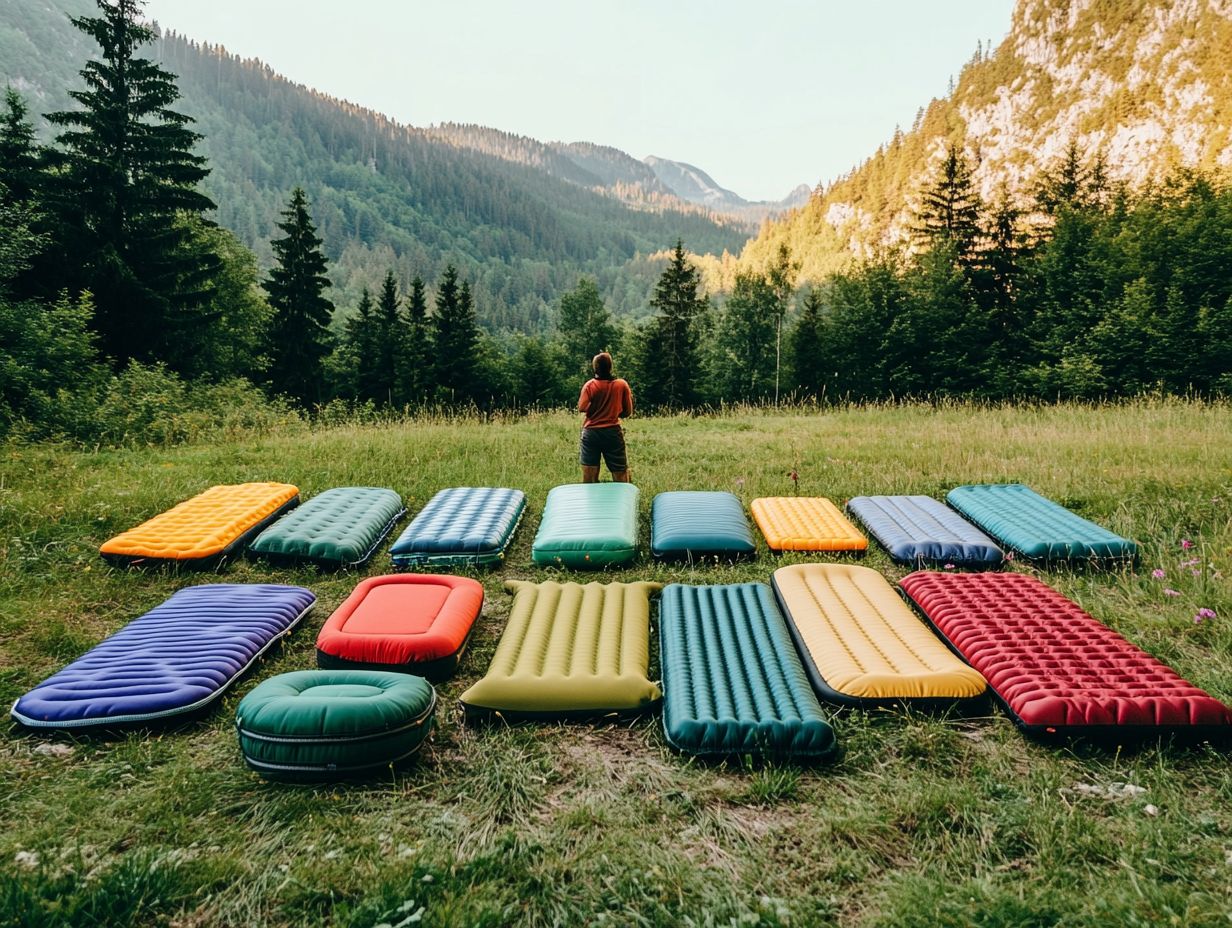
When selecting a sleeping pad, consider key factors that can enhance your camping experience. Focus on comfort, insulation, weight savings, and compactness.
The R-value is crucial as it measures the pad’s insulation effectiveness. It keeps you warm while reducing heat loss on chilly nights.
Consider your camping style when making your choice. The conditions you anticipate will guide you in finding the ideal sleeping system, such as insulated pads tailored to your needs.
Comfort, Insulation, and Weight
When evaluating sleeping pads, the primary considerations are comfort, insulation, and weight. Each plays a crucial role in your overall sleeping experience outdoors.
If you appreciate a plush feel or camp on rocky terrain, a thicker pad provides the cushioning you crave, especially if it includes a foam layer for added comfort.
If you’re heading to colder regions, prioritize pads with a high R-value to ensure effective insulation.
Weight is critical; ultralight options are ideal for multi-day backpacking trips. Here, every ounce matters. However, heavier pads may offer more comfort for leisurely car camping adventures.
Understanding the interplay between these elements allows you to select the perfect sleeping pad whether a self-inflating pad or a closed-cell foam pad tailored to your adventures.
Features to Look for in a Sleeping Pad
When choosing a sleeping pad, thoughtfully consider key features such as size, thickness, and durability among available camping sleeping pads.
A larger size enhances your sleeping space. A thicker pad generally offers superior cushioning and comfort, crucial for ensuring a restful night.
Durability is vital, especially for outdoor enthusiasts. Your pad must endure diverse camping experiences and environmental conditions, particularly for inflatable sleeping pads.
Size, Thickness, and Durability
Size, thickness, and durability are important factors that impact the performance of camping sleeping pads and your comfort during outdoor adventures. A larger sleeping pad gives you room to stretch and relax. A thicker design enhances insulation and comfort, especially in chilly climates, keeping you warm during cold nights.
Durability is crucial for lightweight gear. You want your sleeping pad to withstand rugged terrain and frequent use without failing, especially with foam pads.
On multi-day backpacking trips, every ounce matters. A compact and lightweight pad can make a big difference without sacrificing comfort, especially with efficient packing. In winter camping, thicker pads with added insulation keep the cold ground at bay, allowing for a restful sleep. A durable exterior guards against punctures from sharp rocks, enhancing reliability and making your sleeping pad a true companion in the outdoor industry.
Combining these features creates an ideal sleeping environment. You ll wake up refreshed and ready to embrace the adventures ahead.
Tips for Maintaining and Using a Sleeping Pad
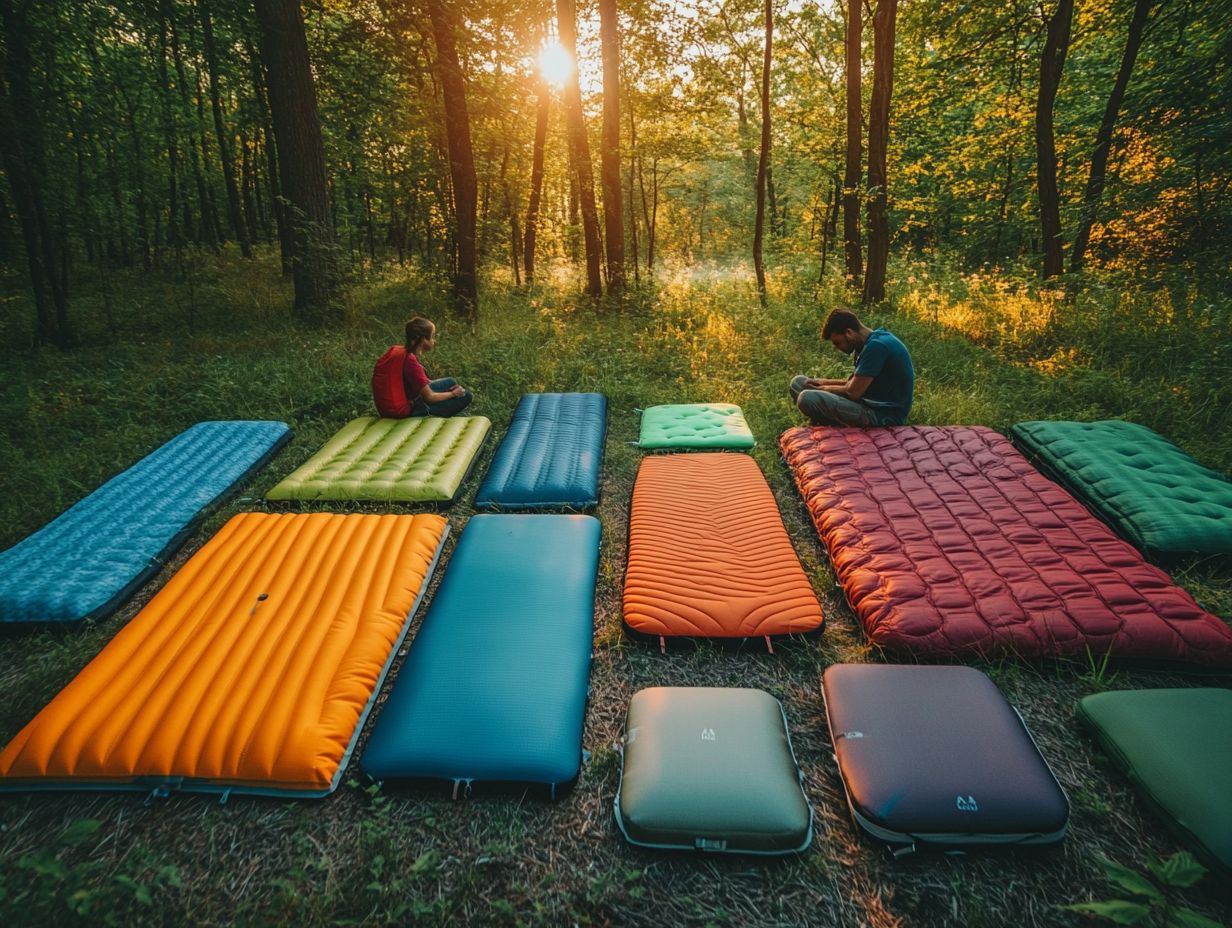
Proper maintenance and usage of your sleeping pad are crucial for extending its lifespan and ensuring effective insulation on your camping trips. To care for your pad, clean it after each use. Store it in a cool, dry place away from sharp objects that could compromise its durability, ensuring your sleeping system remains intact.
Familiarizing yourself with the inflation process whether you have a self-inflating pad (pads that fill themselves with air) or an air-filled design (pads that need blowing up) will enhance its performance. This allows for quick setup and packing.
Proper Care and Storage
Proper care and storage keep your sleeping pad durable and warm. After each use, clean the pad according to the manufacturer’s guidelines. Allow it to dry completely to prevent mold or mildew, which affect its insulation. For storage, keep your pad in a cool, dry place and avoid tightly folding it to preserve its shape and functionality.
Different materials require specific care. For example, foam pads benefit from a gentle wipe with a damp cloth followed by air drying. Inflatable options need a spot clean with mild soap after camping trips. When rolling or storing, avoid sharp bends or creases that could affect the pad’s structure and inflation process.
Make sure the pad is completely dry before stowing it away. Moisture can lead to unpleasant odors and deterioration of insulation, impacting your overall experience.
Regularly checking for small tears or punctures can significantly enhance the pad’s lifespan. This ensures it remains a reliable companion on all your future excursions and enhances your camping experience.
Recommended Sleeping Pads for Different Camping Styles
Selecting the perfect sleeping pad is crucial and can vary dramatically depending on your camping style. Whether you re backpacking, car camping, or enjoying a family outing, there are tailored recommendations for each experience.
For ultralight backpackers, compact and lightweight air-filled pads are typically the way to go. They ensure you carry minimal weight without sacrificing comfort. Conversely, if you re venturing out with family, opting for larger, self-inflating pads can significantly enhance comfort for everyone.
By understanding the distinct requirements of your camping style, you can make an informed and confident choice in your outdoor gear.
Backpacking, Car Camping, and Family Camping
Backpacking, car camping, and family camping each offer unique challenges and requirements for sleeping pads, directly influencing your comfort and overall enjoyment of the great outdoors.
When planning a backpacking trip, it s essential to choose sleeping pads that balance weight and warmth. This way, you can stay mobile without sacrificing comfort, even on chilly nights.
If you re hitting the road for a car camping adventure, dive into thicker options like self-inflating or air mattresses to level up your outdoor experience! These choices can elevate your camping, allowing you to enjoy a rejuvenating night s sleep after a day filled with adventure.
For family camping trips, don t miss out on creating a cozy family nest under the stars! Opt for pads that can accommodate multiple sleepers or can be easily connected.
Aligning your choice of sleeping pad with your camping style will significantly enhance your wilderness experience, ensuring that every camping enthusiast enjoys a truly restful retreat in nature.
Frequently Asked Questions
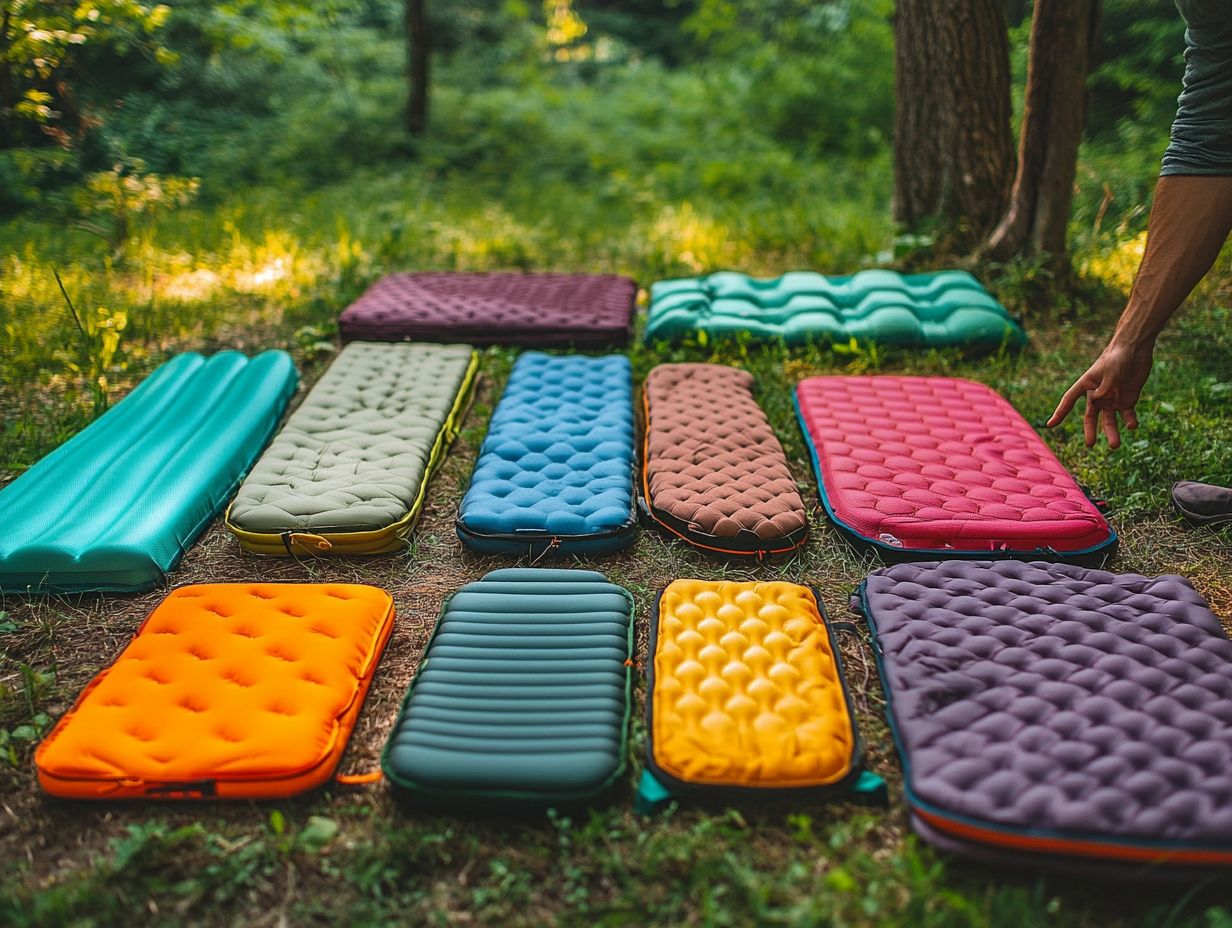
What factors should I consider when selecting a sleeping pad for camping?
When choosing a sleeping pad for camping, consider weight, warmth, comfort, and durability.
What type of sleeping pad should I choose for different weather conditions?
For cold weather, pick a sleeping pad that keeps you warm. In warmer conditions, look for one that allows airflow.
Are inflatable or foam sleeping pads better for camping?
This depends on personal preference and the type of camping you’re doing. Inflatable pads are often more lightweight and compact, while foam pads tend to be more durable and affordable.
How thick should a camping sleeping pad be?
The thickness of a sleeping pad is a matter of personal preference. However, a thickness of at least 2 inches is recommended for comfort and warmth.
What size sleeping pad should I choose for camping?
The size of your sleeping pad should match your tent and your body. Consider your height and width when selecting a sleeping pad.
Can I use a regular air mattress as a sleeping pad for camping?
While it is possible to use a regular air mattress for camping, it may not be the most practical option. Camping-specific sleeping pads are designed to be lightweight, compact, and durable for outdoor use.

